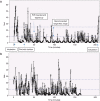The quantification and monitoring of intraoperative nociception levels in thoracic surgery: a review
- PMID: 31656682
- PMCID: PMC6790460
- DOI: 10.21037/jtd.2019.08.62
The quantification and monitoring of intraoperative nociception levels in thoracic surgery: a review
Abstract
Nociception is the unconscious perception of a stimulus applied by trauma or surgery and expressed through a response of the autonomous nervous system. Local anaesthetics (LAs), opioids and other modulating agents such as ketamine are usually utilised to blunt nociception as a component during general anaesthesia (GA) and surgery. The effectiveness of these measures, however, are still difficult to quantify and monitoring of anti-nociception has been confined to assess variation of heart rate (HR) or blood pressure (BP). Recently, various monitoring concepts have been introduced to quantify nociception more systematically and on the other hand guide anti-nociceptive interventions more appropriately. This review describes the various technologies, their performance in clinical studies and provides a critical appraisal with particular application to thoracic anaesthesia and surgery and their relevance in the context of chronic pain after surgery.
Keywords: Thoracic anaesthesia; monitoring; nociception; robot-assisted thoracic surgery.
2019 Journal of Thoracic Disease. All rights reserved.
Conflict of interest statement
Conflicts of Interest: The authors have no conflicts of interest to declare.
Figures
References
Publication types
LinkOut - more resources
Full Text Sources
Medical



